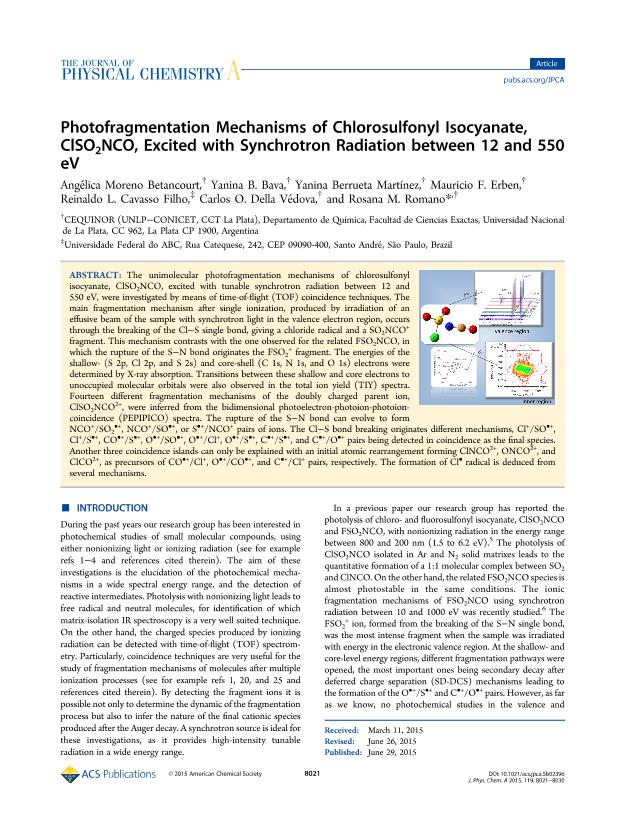Artículo
Photofragmentation Mechanisms of Chlorosulfonyl Isocyanate, ClSO2NCO, Excited with Synchrotron Radiation between 12 and 550 eV
Moreno Betancourt, Angelica ; Bava, Yanina Belén
; Bava, Yanina Belén ; Berrueta Martinez, Yanina
; Berrueta Martinez, Yanina ; Erben, Mauricio Federico
; Erben, Mauricio Federico ; Cavasso Filho Reinaldo L.; Della Védova, Carlos Omar
; Cavasso Filho Reinaldo L.; Della Védova, Carlos Omar ; Romano, Rosana Mariel
; Romano, Rosana Mariel
 ; Bava, Yanina Belén
; Bava, Yanina Belén ; Berrueta Martinez, Yanina
; Berrueta Martinez, Yanina ; Erben, Mauricio Federico
; Erben, Mauricio Federico ; Cavasso Filho Reinaldo L.; Della Védova, Carlos Omar
; Cavasso Filho Reinaldo L.; Della Védova, Carlos Omar ; Romano, Rosana Mariel
; Romano, Rosana Mariel
Fecha de publicación:
07/2015
Editorial:
American Chemical Society
Revista:
Journal of Physical Chemistry A
ISSN:
1089-5639
Idioma:
Inglés
Tipo de recurso:
Artículo publicado
Clasificación temática:
Resumen
The unimolecular photofragmentation mechanisms of chlorosulfonyl isocyanate, ClSO2NCO, excited with tunable synchrotron radiation between 12 and 550 eV, were investigated by means of time-of-flight (TOF) coincidence techniques. The main fragmentation mechanism after single ionization, produced by irradiation of an effusive beam of the sample with synchrotron light in the valence electron region, occurs through the breaking of the Cl-S single bond, giving a chloride radical and a SO2NCO+ fragment. This mechanism contrasts with the one observed for the related FSO2NCO, in which the rupture of the S-N bond originates the FSO2+ fragment. The energies of the shallow- (S 2p, Cl 2p, and S 2s) and core-shell (C 1s, N 1s, and O 1s) electrons were determined by X-ray absorption. Transitions between these shallow and core electrons to unoccupied molecular orbitals were also observed in the total ion yield (TIY) spectra. Fourteen different fragmentation mechanisms of the doubly charged parent ion, ClSO2NCO2+, were inferred from the bidimensional photoelectron-photoion-photoion-coincidence (PEPIPICO) spectra. The rupture of the S-N bond can evolve to form NCO+/SO2•+, NCO+/SO•+, or S•+/NCO+ pairs of ions. The Cl-S bond breaking originates different mechanisms, Cl+/SO•+, Cl+/S•+, CO•+/S•+, O•+/SO•+, O•+/Cl+, O•+/S•+, C•+/S•+, and C•+/O•+ pairs being detected in coincidence as the final species. Another three coincidence islands can only be explained with an initial atomic rearrangement forming ClNCO2+, ONCO2+, and ClCO2+, as precursors of CO•+/Cl+, O•+/CO•+, and C•+/Cl+ pairs, respectively. The formation of Cl• radical is deduced from several mechanisms. (Figure Presented).
Palabras clave:
Photofragmentation
,
Synchrotron
Archivos asociados
Licencia
Identificadores
Colecciones
Articulos(CEQUINOR)
Articulos de CENTRO DE QUIMICA INORGANICA "DR. PEDRO J. AYMONINO"
Articulos de CENTRO DE QUIMICA INORGANICA "DR. PEDRO J. AYMONINO"
Citación
Moreno Betancourt, Angelica; Bava, Yanina Belén; Berrueta Martinez, Yanina; Erben, Mauricio Federico; Cavasso Filho Reinaldo L.; et al.; Photofragmentation Mechanisms of Chlorosulfonyl Isocyanate, ClSO2NCO, Excited with Synchrotron Radiation between 12 and 550 eV; American Chemical Society; Journal of Physical Chemistry A; 119; 29; 7-2015; 8021-8030
Compartir
Altmétricas



